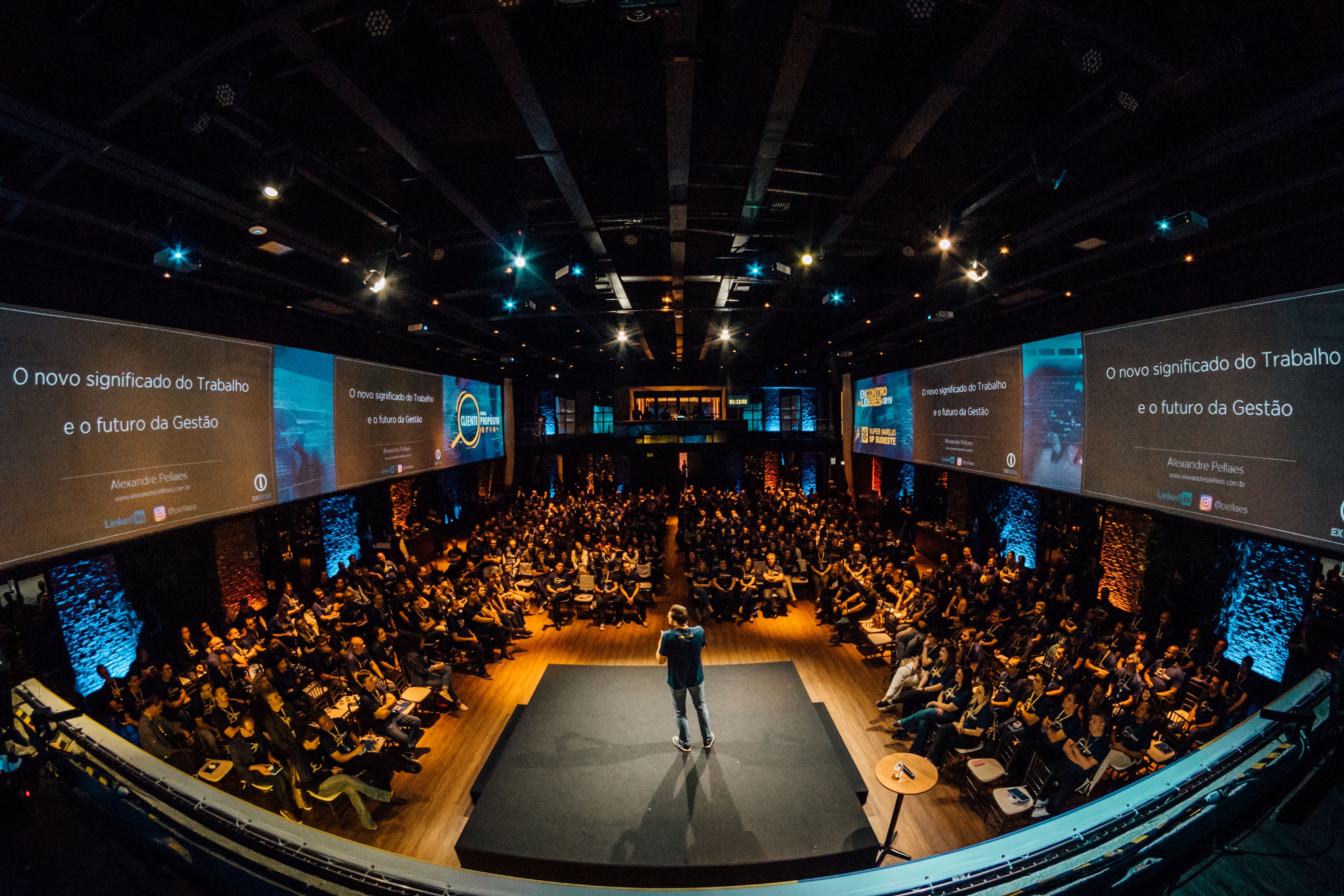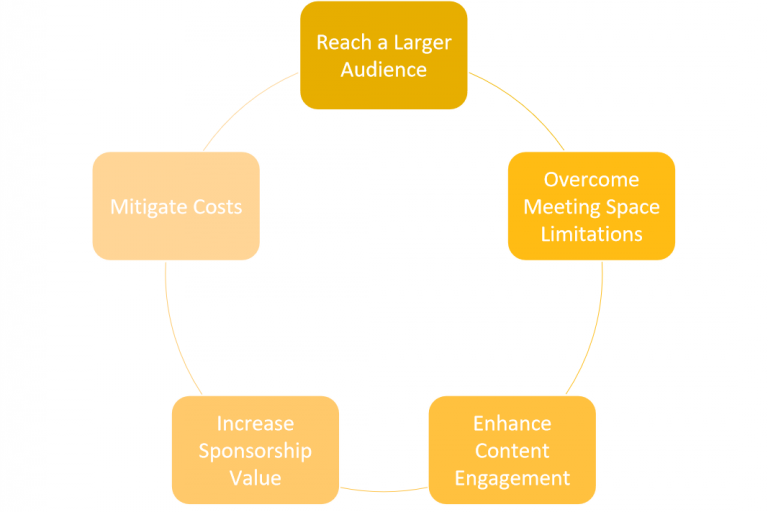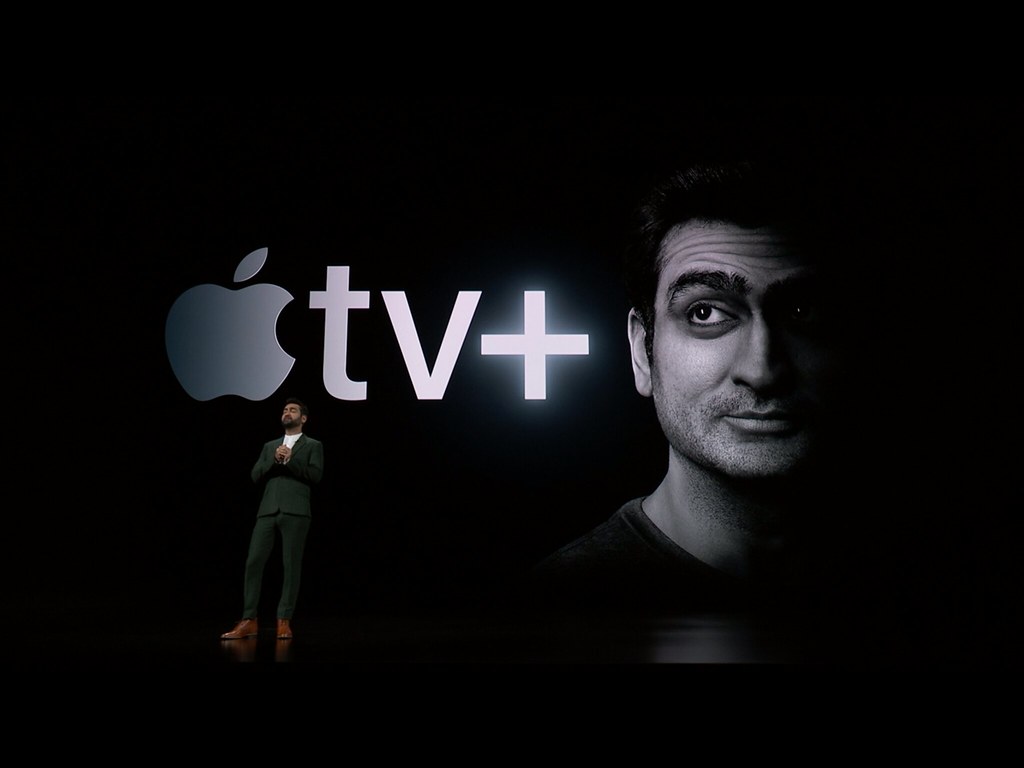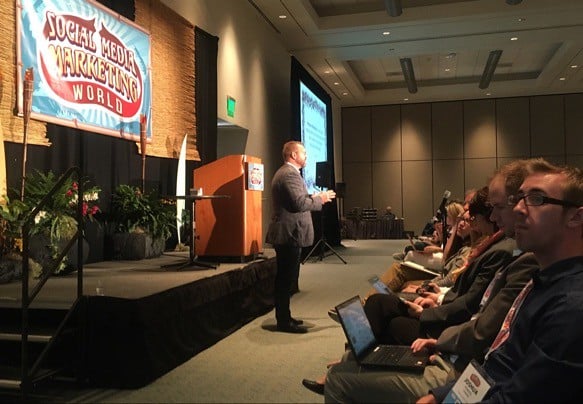The term "hybrid" is being heard a lot lately. But, if we try to understand it in the context of events, what does it truly mean, and what makes it so different? Its definition is straightforward: A hybrid event combines in-person and digital aspects to provide the best possible experience for each audience.
Fortunately, advanced technology has made it easier to design an event that is just as remarkable and engaging online as in person, with so much ease. Good software can not only do effective lead generation but also enable instant feedback.
However, the reality is a little complicated. To build a hybrid event that can help your company achieve its objectives, you must first understand what a hybrid event is, what it can do for you, and most crucially, how to create one!
1. What is a hybrid event?

A hybrid event is a physical event that both online and live audiences can attend and participate in. In essence, online and physical audiences simultaneously attend the same event and engage in the same experience or material from separate locations.
In simple words, hybrid events combine live and virtual events.
You add a digital aspect to your live event where a live audience is also present. The rest goes just like any other event would contain material, discussion and more, so that your audience joins and engages with your live or hybrid event despite their geographical locations.
Interactive program:
Participants in a hybrid event are seated next to their computers. As a result, it is better to consider how your internet audience will participate in the discussion. You can decide on any format such as through chat, quiz, or poll.
Limited time:
A successful hybrid event broadcast takes a good two hours (attention span of the online audience) to focus the energy. This event should have as many people attending online as possible and a live audience.
A clear theme:
Attracting many viewers is simple if you have an exciting and engaging topic. You can pick a precise topic and design your content around it. It should ideally be the topic that most appeals to your target audience.
2. Why are hybrid events gaining popularity?
While all of your events have individual goals, an overarching goal for all hybrid events should be to engage as many attendees as possible. A hybrid event also adds value with the flexibility to engage virtually. The goal is to make the experience equally riveting for both physical and virtual audience groups. Beyond the border, hybrid events provide the opportunity for even more people to interact with your content and your brand.
“Hybrid events are perfect for organisers who look for greater reach and higher flexibility.”

Now that your event is hybrid, you no longer need to worry about the physical limitation in terms of the event scale and audience geography. It will sit in the audience’s mind for a longer period as you can do multi-touch online and repurposed content opportunities throughout the year. Hybrid events also add value to registration revenue and sponsor revenue. Your sponsors have the opportunity to double the exposure they had before. Hosting part of your event in a digital environment creates new opportunities for brand awareness and lead generation. By offering your sponsors more value, your event will attract more sponsorship dollars and even more sponsors.
3. Benefits of hosting hybrid events
One most prominent goal of every event is to achieve maximum attendee involvement. Your purpose should be to create a safe environment where people can learn new things and connect in the ways they wish.
Since your hybrid event lets attendees take part in your event from any location and on any device, this adaptability provides your audience with many opportunities to interact and connect right away, helping you reach your goal.
Besides that, there are other benefits to conducting a hybrid event. Below are a few that pays off the best!
Increased attendance and reach:

Giving your audience the flexibility of choosing between live or online events gives them a sense of involvement and inspires them to participate. The trick is to offer adaptability. Others who are at ease with the live event can join on-site, while those who cannot travel to the venue or want to participate from their homes can do so digitally.
Due to scheduling problems, or money constraints, not everyone can attend the event live. In such circumstances, your audience can still be present at the event, ensuring that they do not miss out on the experience entirely. As a result, it assists you in community building.
More opportunities to engage with the audience:

Networking is not restricted to in-person networking at hybrid events. You can have people coming in from all over the world; thus, making your event international. The only prerequisite for a live stream is a piece of sound, audiovisual equipment. Your online attendees can join the ongoing discussion session, participate in the Question and Answers, and vote on polls to stay engaged with presentations.
4. Examples of Hybrid Events
1. Apple Special Events

Apple Special Events is an annual event that Apple has hosted since 2006. The company chose the mode of hybrid events because it can ensure a wide range of audiences from across the world can get hold of the latest information on Apple’s newly launched products every year.
2. Social Media Marketing World

Social Media Marketing World is a large hybrid conference for digital marketers to gather and exchange information. There are more than 100 of the world’s social media experts to share the advertising strategies and skills in content marketing with attendees from all over the globe.
5. How to create a hybrid event?

Hybrid events provide a wide range of benefits for event planners and marketers, and they have come to stay for sure.
When planning a hybrid event, the foremost question you should answer is: how can this event help me reach my goals? To do so, plan out your event marketing, keeping in mind both: the audience you want to achieve and your goals.
A typical hybrid event online broadcast revolves around the following elements that you must pay the most attention to:
Step 1. Prepare a preview:
A preview lays the foundation for the context and the topic under discussion. This is an excellent way to announce essential speakers who will lead the event. Alternatively, highlight portions of events that occurred at different times, such as snapshots of other sessions, interviews, etc.
Step 2. Select a moderator
There must be a moderator to convey questions from online participants to the event speaker. If a live recording of a presentation or seminar is held, with the possibility of online questioning, the online moderator can collect these questions and be directed to the speaker leading the event.
Step 3. A concluding session:
An exclusive Question/Answer session with the keynote speaker can be a significant drawcard, especially for your online audience. If not the Q & A session, you can address a summary of the whole discussion. Moreover, you can also ask for instant feedback using suitable software.
Step 4. Choose the right platform for the event:
EventX is a well-known virtual video conferencing platform known for its simple functioning. It is excellent for hosting hybrid events because of its easy-to-understand interface and many other capabilities like lead generation.
It is the ultimate solution for all event management tasks for both organizers and attendees. It has served over 135 countries and conducted almost 10,000 events attended by over 5 million people. Top companies and significant trade associations have chosen to adopt this all-in-one platform.
Another reason why we recommend EventX is its various features for community building. Even the participants joining for the first time on an EventX event can understand it.
6. Best Practices for Hybrid Event Organisers
(1) Extra Preparation and Rehearsals
- The hybrid event information such as slides, videos and PDFs has to be loaded onto the web streaming portal and tested in advance.
- The exact requirements will depend on the system and provider but make sure you understand fully the deadlines and complexities and how much flexibility (if any) there is for changes.
- Speakers should be able to talk through and understand the technology with the event planner and technicians. Ideally, there should be time for a short rehearsal.
- Have a short briefing with speakers on how to come across well on camera.
- A dry run is a must to ensure technology works properly and speakers can be seen and heard clearly. Be aware of the sound and ensure presentation visuals can load without a hitch.
(2) Timing the Event
- Have a stream rewatch session with the speakers available for personal interaction.
- Break down your target audience by time zones and consider their normal work days.
- Set a timed schedule for strong engagement.
- Make recordings available afterwards for attendees who missed the sessions.
- Schedule breaks that are long enough for audiences to have meetings/discussions in between livestream sessions.
- Leverage the Social Influence
- Create a dedicated Event Hashtag
- Encourage speakers, exhibitors, sponsors and participants to use the branded hashtag throughout the event across different channels
- Filters, badges and geo-tagging can be some fun ways to engage audiences on social media
(3) Engagement Deepens with Networking
- The virtual event platform should include feedback loops, Q&As and chat rooms
- Inclusion of social media hashtags, video feed from pop-up venue and even live chat to take the conversation across channels
- Have a team monitor the submissions, field questions and get them to the speakers promptly.
- Assign online moderators to chat rooms to post opinions and encourage input
- Speakers are advised to encourage assimilation of information and personal connection
Contact us to learn more about strategies for organisers
(4) Capture Relevant Virtual Experience Analytics
Testing and iteration are key components to your continued success. Measurement of in-event metrics, e.g. engagement points, speaker approval, onsite conversion, sponsor touchpoints, etc. should be taken. The most ideal way is to operationally connect your virtual tools to your event platform. This allows for better continuity and higher operational efficiency when designing a hybrid event and it keeps all your data in one place.
A good hybrid event platform can collect data from all of your applications, from the registration process to the stats on your landing pages, into one master dataset. Event organizers and exhibitors will be able to view the aggregated data and create actionable reports that give the complete story of your hybrid event performance.
Due to the advantages that hybrid events have fewer physical limitations, increased sponsorship values and content engagement, it is of no question that this type of event has already become a new trend in recent years. It is hoped that event professionals will bear in mind the aforementioned principles of practices while organising hybrid events.
Looking for more resources on planning a hybrid event? Download the white paper for tips and event trend prediction now.
Conclusion
The hybrid event broadcast is ideal for watching events with others, which further surges participation. It is also a remarkable way to interact with people on a good level of connection. However, picking the wrong platform will sabotage your entire experience. Make the wise decision and go with EventX. What you will get are the fantastic features exclusively for you.
Frequently Asked Questions About Hybrid Events
What are hybrid events?
Simply put, hybrid events combine live and virtual elements to innovatively increase audience reach and engagement. Since the last couple of years, many events have been implemented in a hybrid fashion due to the COVID-19 safe management measures in place.
How to host hybrid events?
Hybrid events can be hosted in a few ways such as:
- Having two groups of audiences; a physical audience at the event venue and a virtual audience online,
- Live streaming an event that is hosted at a main physical venue to audiences across other smaller venues, and
- Having all speakers present in an event space, while the audience watch a live stream of the event from wherever they are.
How are physical, virtual and hybrid events different?
A physical event requires all attendees to be physically present in an event space at the time of the event, while virtual events are events that everyone attends online. Hybrid events merge physical events and virtual events together, so some people attend the event physically at the venue while others attend virtually.
Are there benefits to organizing hybrid events?
Since hybrid events are a combination of physical and virtual events, they offer the best of both worlds in terms of possibilities and benefits, including:
- Increased reach to audiences as hybrid events are not bounded by geographical locations
- Enhanced audience engagement virtually becomes easier
- Flexibility in carrying out events in the midst ever-changing safety measures
